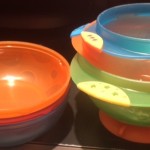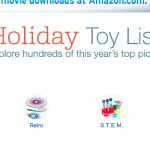My daughter’s toothpaste just got a lot cheaper.
Last month, the American Dental Association announced that it now recommends brushing the teeth of those under age 2 with a tiny smear (the size of a grain of rice) of fluoride toothpaste.
This means that I no longer have to buy my 19 month old a special fluoride-free toothpaste, which she has been using since she began wanting her teeth brushed with toothpaste rather than just water. Instead, my daughter can just use the same whitener-free, low-abrasive toothpaste as my husband and me.
Toothpaste is just one of a host of “adult” personal and household care products that parents can share with their babies instead of buying separate “adult” and “baby” versions. Cutting drugstore and big box store bills by making such dual-use purchases is today’s hint.
So which products make the cut? As I’ve written before, there’s no need to buy a special baby thermometer, as adult thermometers work just fine on babies too. Meanwhile, assuming your baby doesn’t have particularly sensitive skin, experts say it’s totally fine to use your regular adult detergent to wash your baby’s clothes.
Toothpaste, thermometers and laundry detergent are just three of products I include in my full list of shareable products over at The Frugal Shopper, a new U.S. News Money blog.
If you like the idea of sharing toothpaste, experts say to make sure to go with an adult toothpaste that doesn’t contain whiteners, which are too abrasive for kids’ soft enamel, and to go for a low-abrasive toothpaste (like regular Colgate).
You can tell if a toothpaste is low abrasive by finding out its “Relative Dentin Abrasivity” (RDA) number. Toothpastes with an RDA of about 0 to 70 are considered low abrasive. Here’s a helpful explainer on toothpaste abrasiveness and a list of rankings from the site Frey Smiles. You can also find out the RDA of your toothpaste by calling the customer service number on the package.
To be sure, some parents (like many moms in the What to Expect community) prefer to use baby products on themselves, sharing with their baby that way. If you prefer to go that route toothpaste wise, you could just opt for Crest, Colgate or Toms of Maine toothpastes designed for children, using those tubes on your own teeth as well. Kids may like the flavor of such toothpastes more than minty adult paste flavors.
In addition, keep in mind that oral health experts say that everyone in the family should have their own toothpaste tube to avoid sharing mouth bacteria. So if you follow that recommendation (we don’t in our house), then you can still save money by buying baby-friendly adult toothpaste in bulk.
Or if you only have one toothpaste tube and are worried about sharing it, an oral health expert recommends not putting the paste directly on brushes and instead putting the paste into a clean cup and then scooping it out with the brush.
The bottom line: With products marketed for babies often coming with more expensive price tags, sharing adult aisle items can be the cheaper shopping strategy. Read the full piece over at The Frugal Shopper.
What adult products do – or did — you share with your babies and toddlers?
Follow Hint Mama on Facebook and Twitter, and read more about her and her disclosures.







Did you come across anything about triclosan in your research? I’ve been meaning to do a more thorough search on its effects, especially in small people. But I think it still shows up in many toothpaste brands, which is why I’ve continued to spend the extra $ on the Weleda all natural stuff (though even that’s questionable! http://www.goodguide.com/products/178696-weleda-childrens-tooth-gel). Thanks for the post!
I didn’t. The oral health expert I checked in with just emphasized looking for an adult toothpaste with a low RDA number and no whiteners or going for a kid-friendly toothpaste with fluoride like the ones mentioned above. Interesting that regular Colgate actually has a higher health rating than the Weleda one: http://www.goodguide.com/products/419438-colgate-cavity-protection-fluoride I’ll add looking into triclosan to my hint to-do list:) Thanks for the comment!